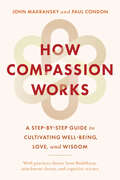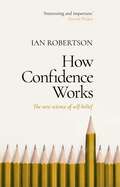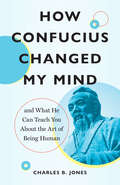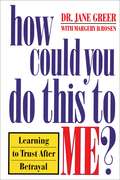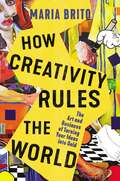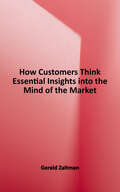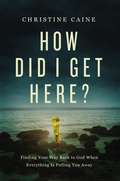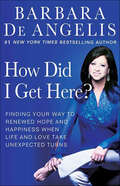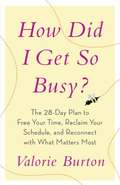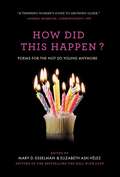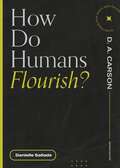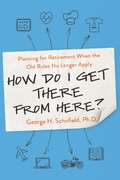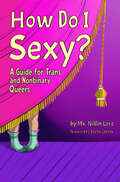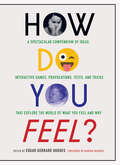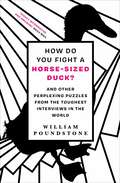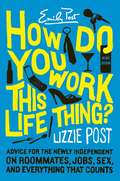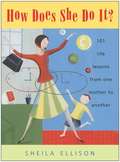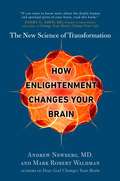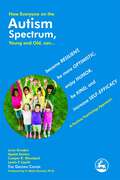- Table View
- List View
How Compassion Works: A Step-by-Step Guide to Cultivating Well-Being, Love, and Wisdom
by John Makransky Paul CondonUncover your innate capacity for love, presence, and wisdom with compassion training adapted from Tibetan Buddhism and contemporary psychology.Everything we care about—our mental and physical well-being, our relationships, our spiritual life, our ability to be useful to others—depends on our ability to access love and compassion within ourselves first. This clear, step-by-step guide offers a way to cultivate this power through an evidence-based meditation method called Sustainable Compassion Training (SCT). With practices drawn from Tibetan traditions, attachment theory, and cognitive science, How Compassion Works uses a progressive series of meditations to gradually build our capacity for mindfulness and presence—and to help us avoid empathic distress, compassion fatigue, or burnout. Organized into three categories—receptive mode, deepening mode, and inclusive mode—these practices help us cultivate unconditional care and discernment from within. With a flexible framework that allows practitioners to integrate their own religious or spiritual beliefs, this book offers practices suitable for people of all faiths and those seeking a purely secular path.
How Confidence Works: The new science of self-belief
by Ian Robertson* Confidence makes your brain work better and boosts your performance* Confidence acts like a mini-antidepressant, lifting your mood* Confidence is contagious* Confidence is anxiety's greatest antidote* Confidence is a set of habits that feel fake at first but become real with practice* Confidence makes boys bullsh*t more than girls* Overconfidence can have disastrous consequences_________'Brilliant ... it will change how you think about confidence.' Johann Hari'Important for everyone but crucial for women.' Mary Robinson'Interesting and important.' Steven Pinker__________Imagine we could discover something that could make us richer, healthier, longer-living, smarter, kinder, happier, more motivated and more innovative. Ridiculous, you might say... What is this elixir?Confidence.If you have it, it can empower you to reach heights you never thought possible. But if you don't, it can have a devastating effect on your future. Confidence lies at the core of what makes things happen.Exploring the science and neuroscience behind confidence that has emerged over the last decade, clinical psychologist and neuroscientist Professor Ian Robertson tells us how confidence plays out in our minds, our brains and indeed our bodies. He explains where it comes from and how it spreads - with extraordinary economic and political consequences. And why it's not necessarily something you are born with, but something that can be learned.__________'Rich stories and change-inspiring examples for every kind of performer.' Pippa Grange'Appealing... ranges from neuroscience to politics.' Nature
How Confucius Changed My Mind: And What He Can Teach You about the Art of Being Human
by Charles B. JonesA compelling exploration of humanity, morality, religious practice, and leading a good life based on traditional Confucian thought.In this exploration of humanity, morality, religious practice, and leading a good life based on traditional Confucian thought, you are invited on a path of transformation. The unexpected depths to be found in Confucianism surprised author Charles Jones when he began teaching East Asian religions to undergraduate students thirty years ago. It raised fascinating questions relevant to life today, like what does it mean to be human? To understand the Confucian answers to these questions, Jones familiarizes us with Confucius, his main successors, and the situations to which their writings responded.But this is not another textbook introduction to Chinese religion and thought. Jones is an engaging, inquisitive scholar and thought provocateur whose ideas address problems all of us face throughout our lives. By engaging with the Confucian ideas explored in this book, like rethinking &“human nature&” and uncovering cultural presuppositions previously unnoticed, you might discover new horizons and possibilities for your life that previously you never could have imagined. And you will discover Confucius in an all-new light as a profound shaper of modern thought as much as Aristotle and Lao-tzu—whose revolutionary ideas have the power to change your mind for the better.
How Could You Do That?!
by Dr Laura SchlessingerHow Could You Do That?! illustrates Dr. Laura Schlessinger's philosophy of personal responsibility through her usually provocative but always stimulating moral dialogues with callers about everyday ethical dilemmas.In her lively pull-no-punches style, Dr. Laura takes on the moral dilemmas of our time: from the mindless pursuit of pleasure and immediate gratification to taking the easy way out when those actions produce ugly or uncomfortable life-altering consequences. She demonstrates in no uncertain terms that personal values are never someone else's reponsibility but your own, and why choosing not to honor them actually compounds unhappiness. Finally she explains that by disciplining self-indulgence and rising above temptation we can discover the infinite pleasures, the true happiness, of the moral high ground.Dr. Laura delivers not only a compelling argument for an ethical approach to life but also an invaluable inspiration to rebuilding character, conscience, and courage. Here is a work that can make a genuine difference in the quality of your own life and the lives of those we love.
How Could You Do That?!
by Laura SchlessingerHow Could You Do That?! illustrates Dr. Laura Schlessinger's philosophy of personal responsibility through her usually provocative but always stimulating moral dialogues with callers about everyday ethical dilemmas. In her lively pull-no-punches style, Dr. Laura takes on the moral dilemmas of our time: from the mindless pursuit of pleasure and immediate gratification to taking the easy way out when those actions produce ugly or uncomfortable life-altering consequences. She demonstrates in no uncertain terms that personal values are never someone else's reponsibility but your own, and why choosing not to honor them actually compounds unhappiness. Finally she explains that by disciplining self-indulgence and rising above temptation we can discover the infinite pleasures, the true happiness, of the moral high ground. Dr. Laura delivers not only a compelling argument for an ethical approach to life but also an invaluable inspiration to rebuilding character, conscience, and courage. Here is a work that can make a genuine difference in the quality of your own life and the lives of those we love.
How Could You Do This to Me?
by Jane GreerAt one time or another we have all been betrayed by someone we trusted, all felt the sting of deceit and subsequent shattering of self-confidence. And when the people we count on betray our trust, the wound is deep and long-lasting.In How Could You Do This to Me?, Dr. Jane Greer teaches readers:the types of people who are more at risk of betrayal the warning signs of someone who is untrustworthy a process that helps decide whether a relationship is worth saving or whether it should be abandoned.Part One discusses the roots of trust, blind trust, and the reasons betrayers betray. Part Two reveals our betrayers' many faces: admirers, users, or rivals. Part Three focuses on the fallout from betrayal: confrontation, revenge, and betrayal, and talks about how you can learn to trust your judgment and others again.From the Trade Paperback edition.
How Creativity Rules the World: The Art and Business of Turning Your Ideas into Gold
by Maria BritoLearn to make creativity work for your career.Anyone, regardless of who you are or what you do, can cultivate the habits, actions, and attitudes that inspire creativity and foster innovation.Creativity is the key to innovation in any business. How Creativity Rules the World shows that, despite contrary beliefs, creativity is an inexhaustible resource that can be learned by anyone.This timeless guide promises to make the creative process of billion-dollar entrepreneurs and successful seven-figure artists accessible and actionable for you. With revealing studies and stories spanning business and art, this book is a deep dive into history, culture, psychology, science, and entrepreneurship; analyzing the elements used by some of the most creative minds throughout the last 600 years.In How Creativity Rules the World, you will learn how to:Overcome limiting thoughts and dispel myths about creativity.Understand creativity through concrete data, historical passages, and examples of modern entrepreneurship.Develop timeless habits, principles, and tools that worked six centuries ago and continue to work today.Employ creativity in an everyday context to produce extraordinary results.Contemporary art curator and writer of the popular newsletter, The Groove, Maria Brito discovered the power of creativity when she transitioned from being an unhappy Harvard-trained corporate lawyer to a thriving entrepreneur and innovator in the art world. After applying the principles in How Creativity Rules the World to her own business, Maria started teaching struggling professionals, ranging from entrepreneurs to artists to CEOs. Proven by her students&’ creative successes, Maria will guide you to strike gold with your ideas as well.There has never been a more crucial time than now to develop your creativity and your ability to innovate. Coming up with original ideas of value is today&’s most precious skill.
How Customers Think: Essential Insights into the Mind of the Market
by Gerald ZaltmanHow to unlock the hidden 95 percent of the customer's mind that traditional marketing methods have never reached. This title provides a practical synthesis of the cognitive sciences. Drawing heavily on psychology, neuroscience, sociology, and linguistics, Zaltman combines academic rigor with real-world results to offer highly accessible insights, based on his years of research and consulting work with large clients like Coca-Cola and Procter & Gamble. An all-new tool kit: Zaltman provides research tools - metaphor elicitation, response latency, and implicit association techniques, to name a few - that will be all-new to marketers, and demonstrates how innovators can use these tools to get clues from the subconscious when developing new products and finding new solutions, long before competitors do.
How Cycling Can Save the World
by Peter WalkerPeter Walker—reporter at the Guardian and curator of its popular bike blog—shows how the future of humanity depends on the bicycle. Car culture has ensnared much of the world—and it's no wonder. Convenience and comfort (as well as some clever lobbying) have made the car the transportation method of choice for generations. But as the world evolves, the high cost of the automobile is made clearer—with its dramatic effects on pollution, the way it cuts people off from their communities, and the alarming rate at which people are injured and killed in crashes. Walker argues that the simplest way to tackle many of these problems at once is with one of humankind's most perfect inventions—the bicycle. In How Cycling Can Save the World, Walker takes readers on a tour of cities like Copenhagen and Utrecht, where everyday cycling has taken root, demonstrating cycling’s proven effect on reducing smog and obesity, and improving quality of life and mental health. Interviews with public figures—such as Janette Sadik-Khan, who led the charge to create more pedestrian- and cyclist- friendly infrastructure in New York City—provide case studies on how it can be done, and prove that you can make a big change with just a few cycling lanes and a paradigm shift. Meticulously researched and incredibly inspiring, How Cycling Can Save the World delivers on its lofty promise and leads readers to the realization that cycling could not only save the world, but have a lasting and positive impact on their own lives.From the Trade Paperback edition.
How Did I Get Here?: Finding Your Way Back to God When Everything is Pulling You Away
by Christine CaineDo you feel lost? Disconnected? Like you&’re just going through the motions?When you don&’t know the next step to take, God&’s grace empowers you with a way forward. His hope offers an anchor for the soul and a way to get back on track. His faithfulness declares that wherever you are now, he is always ready to bring you home.As a respected Bible teacher, author, and activist, Christine Caine knew that Jesus was her only anchor. But after an especially difficult season, she found herself drifting, unsure if she wanted to keep going the way she always had and asking, &“How did I get here?&” as she struggled to return to the steadiness of God&’s purpose for her. Where she once wanted to take ground, she now just wanted to take cover. It was a bewildering and disorienting place to be—one you may also have found yourself in before.With refreshing candor and relatable humor, Christine offers biblical insights helping youidentify nine signs you are drifting off course and realign with God&’s purpose;ask the right questions about your relationships with God, others, and your own heart so you can stay anchored in truth despite the world&’s shifting currents;move from a what-if faith to an even-if faith as you discover how to trust God more deeply; andwrestle honestly with your soul&’s longings so we can respond to all the ways God answers—even when it feels like he doesn&’t.Writing for all who feel empty of the spiritual passion they once knew, Christine vulnerably shares her journey of turning her eyes back to Jesus in her thoughts, prayers, actions, and the hard questions she asked along the way.
How Did I Get Here?: Finding Your Way to Renewed Hope and Happiness When Life and Love Take Unexpected Turns
by Barbara De AngelisAll of us find ourselves, at one time or another facing the unexpected and asking "How did I get here?" Whether because of disappointments in love, crises in health, family or finances, professional dissatisfaction, or events beyond your control, life doesn't look like you expected or intended it to. HOW DID I GET HERE? is a groundbreaking inspirational handbook for anyone of any age going through change, challenge or reevaluation in any aspect of their lives. It is about finding your way to renewed hope and happiness from wherever you are. Renowned transformational teacher Barbara De Angelis masterfully guides you through an understanding of your own life lessons, and teaches you how to successfully use whatever you're going through as a springboard for regeneration and rebirth.We live in turbulent times of profound change, and many of us find ourselves at emotional and spiritual crossroads.HOW DID I GET HERE? offers illuminating teachings and practical, innovative techniques that free you to move forward into a life of renewed optimism, true contentment and courageous awakening. With her remarkable blend of timeless wisdom, practical techniques and down-to-earth advice, Barbara De Angelis helps you to : *Recognize and understand the significant transitions, turning points, and wake-up calls on your path *Transform fear into courage, confusion and into vision, and self-doubt into confidence *Turn what appear to be dead ends into doorways *Reclaim your passion and purpose for living and loving *Discover freedom, fulfillment and authenticity from the inside out Written with Barbara De Angelis' trademark eloquence, honesty and compassion, and containing the treasures of her own thirty-five year quest for enlightenment, HOW DID I GET HERE is a more than uplifting, intimate and moving--it is a true transformational manual for achieving emotional and spiritual rebirth that will change your life.
How Did I Get So Busy? The 28-day Plan to Free Your Time, Reclaim Your Schedule, and Reconnect with What Matters Most
by Valorie BurtonDo you feel stressed, overworked, like you're running on empty? Are you caught in the race to get it all done--with little time to enjoy the rewards life has to offer? There's no doubt about it: these days we are just too busy. With the conveniences of technology, we're compelled to get more done in less time and end up constantly striving for the next thing - rarely stopping to consider if it's something we even want. As a result, we end up missing out on the things that truly matter: our relationships, the activities we love, quiet time to reflect and replenish our energy. Valorie Burton's How Did I Get So Busy? is the solution for anyone who feels perpetually overwhelmed and overworked: a simple, effective 28-day program to help you rediscover your true priorities, shift out of overdrive, and reclaim your life and schedule. Built around Burton's "Ten Commandments of Self-Care," each day presents an easy-to-follow task to help you strip away the meaningless activities that occupy your time and make room for what nourishes you--mind, body, and spirit. The tasks are simple but yield big rewards: Take a full hour for lunch Set "no-email" periods Add fun goals to your to-do list End your day "on purpose" - meaning that you decide when to leave the office, head home, and fall asleep. Uplifting and inspiring, How Did I Get So Busy? offers an easy way to be rid of the busywork that fills our days and rediscover the life you've always wanted.
How Did This Happen?: Poems for the Not So Young Anymore
by Mary D. Esselman Elizabeth Ash VelezFrom the bestselling authors of The Hell with Love, a fierce, funny, touching collection that takes the sting out of "aging while female."
How Do Humans Flourish? (Questions for Restless Minds)
by Danielle SalladeExperience life under Jesus' yoke. Everyone wants to succeed in life. But do you know what success looks like? Is true flourishing found in a busy life pursuing money, status, and experiences? Or is there a better way? In How Do Humans Flourish?, Danielle Sallade argues that the Christian life leads to thriving. Many burden under the yoke of worldly success, resulting in stress, anxiety, and exhaustion. But true flourishing can be found only in peace, and that begins with a right relationship with God. Learn what true success looks like. Discover how you can value work rightly, find your identity in Christ, and live with an attitude of dependence on God. You too can flourish. The Questions for Restless Minds series applies God's word to today's issues. Each short book faces tough questions honestly and clearly, so you can think wisely, act with conviction, and become more like Christ.
How Do I Get There from Here?: Planning for Retirement When the Old Rules No Longer Apply
by George SchofieldNo matter how far or close you think you are to retirement, this book is your one-stop guide to help you plot your direction for the coming decades.Not long ago everyone knew what the word retirement meant--retire at age 65 after 40 years at the same job and coast through your golden years courtesy of a comfortable nest egg. But now, age expectancy is higher, savings are slimmer, and people change jobs more frequently. Clinging to this outdated concept of retirement only gets you a room in your kids&’ house. Your retirement is going to require an incremental approach to planning--and you must begin now. This requires conscious engagement, diverse interests, and the ability to adapt.In How Do I Get There from Here?, readers will first be directed how to review all their assets--both tangible and intangible--so they can get an honest assessment of where they are right now. Then a journey through self-reflective questions and exercises will:walk you through imagining your future,identifying skills you&’ll need,and learning how to prepare for inevitable twists and turns along the way.Stop clinging to an ancient and stereotypical idea of retirement. Decades of nonstop leisure is not only unreachable for most, it&’s not even truly desirable. Begin now charting the path for a unique, dynamic future you can look forward to!
How Do I Sexy?: A Guide for Trans and Nonbinary Queers
by Mx. Nillin LoreWhat even is "sexy," and how do you do it? A tough question for trans and nonbinary queers struggling to find their sexual selves in a landscape rife with misogynistic, transphobic and homophobic ideals and expectations. In How Do I Sexy?, Mx. Nillin Lore provides affirming and helpful direction based on over a decade of their own personal and professional experience as an educator, advocate, support worker and award-winning sex blogger. You're invited to do some deep introspection, find a look that feels right and gain insight on sexiness from fellow trans and nonbinary queers. You'll also find valuable tips on navigating dating sites, finding community, managing rejection with grace and engaging in sexual relationships. Principled and compassionate, Mx. Nillin Lore will help you figure out who you want to be, who you want to be with and how to make it happen— both in the streets and between the sheets.
How Do You Choose?: A Human Design Guide to What's Best for You at Work, in Love, and in Life
by Erin Claire JonesDo you know what career you’re really meant to pursue? Can you identify the relationships you should really be investing in? Are you living your life to the fullest? Human Design is a mystical personality assessment that uses NASA data, astrology, and Eastern philosophy to generate mind-blowingly accurate insights into how you uniquely thrive at work, in love, and beyond.In How Do You Choose?, world-renowned Human Design coach and educator Erin Claire Jones offers a roadmap to using this cosmic system as a practical tool for transformation.Written as an easy-to-understand guide, Jones shares relatable stories from her own life, case studies from her work with thousands of clients, examples of how influential figures like Nelson Mandela, Taylor Swift, Beyoncé, Maya Angelou and more have used their Human Design gifts to change the world, actionable tips for immediate transformation, and more than a hundred journaling prompts.After reading, you will learn:The professional roles you’re designed to pursue The relationship dynamics that make you feel most seenYour most potent communication strategies with colleagues, family, and friendsThe gifts you bring to a team and how you can be most effectiveThe way you are uniquely designed to make decisions of all kindsAlong the way, you will also become fluent in the language of Human Design as you dive into the fundamentals of Type, Strategy, and Authority, and discover how these elements can influence every decision you make.Whether you want to advance your career, motivate others to change, take creative risks, find deeper connections, build better habits, start a new chapter, or simply create more happiness in your life and relationships, How Do You Choose? offers you a resource to shift your mindset and unlock your full potential.
How Do You Feel?: Understand Your Emotions through Charts, Tests, Questionnaires, and Interactive Games
by Edgar Gerrard HughesAn insightful and fun interactive guide to understanding the what, how, and why of your emotions.Almost every moment of our lives is suffused with emotion, yet we rarely think about what these emotions mean, how they're formed, and how to address them. How Do You Feel? gathers decades of recent research on emotions in accessible short essays and engaging activities that let you be your own guide in learning about your emotions. With questionnaires, quizzes, assessments, and more, How Do Your Feel? is great for groups or individuals, and will entertain, inform, surprise, and help you get to know yourself better.
How Do You Fight a Horse-Sized Duck?: And Other Perplexing Puzzles from the Toughest Interviews in the World
by William PoundstoneEvery year, millions of applications stream to a handful of companies that regularly top the listings of best employers: Apple, Netflix, Amazon, Alphabet, Disney, SpaceX, Oracle, PricewaterhouseCoopers and others. In 2017, Tesla received as many as 200 applications for each vacancy, making it ten times more selective than Harvard. The only way to choose who to hire is with uniquely demanding questions that test imagination, persistence and creativity. Questions like: How is a milk carton like a plane seat? Why don&’t animals have wheels? What would happen if you drilled a hole all the way through the Earth and jumped in it? How Do You Fight a Horse-Sized Duck? explores the new world of interviewing at A-list employers. It reveals more than 70 outrageously perplexing riddles and puzzles and supplies both answers and general strategy for creative problem-solving.
How Do You Kill 11 Million People? (International Edition): Why the Truth Matters More Than You Think
by Andy AndrewsIt all comes down to the truth.Much like the character in one of his best-selling books, Andy Andrews is first and foremost a Noticer. Sometimes, all one needs is a little perspective and Andy has been providing that perspective to some of the world's most influential companies and organizations for the last 20 years. His ability to transform an individual by their own understanding and desire has made him loved by millions.Now, Andy Andrews brings his lessons and perspective into the important arena of government, citizenship, and what it means to completely uphold the truth. If the truth is what sets us free, what does it mean to live in a society where truth is absent? How do truth and lies in the past shape our destiny today? Through the lens of the Holocaust, best-selling author Andy Andrews examines the critical need for truth in our relationships, our communities, and our government.In this compact, nonpartisan book, Andrews urges readers to be "careful students" of the past, seeking accurate, factual accounts of events and decisions that illuminate choices we face now. By considering how the Nazi German regime was able to carry out over eleven million institutional killings between 1933 and 1945, Andrews advocates for an informed population that demands honesty and integrity from its leaders and from each other. The future of our country rests on the ability to separate the truth from lies, and Andrews compels each of us to examine our leaders' claims with a critical eye. His question-- how do you kill eleven million people?--is provocative, but his warning is clear: "Only a clear understanding of the answer to this question and the awareness of an involved populace can prevent history from continuing to repeat itself as it already has, time and again."
How Do You Kill 11 Million People?: Why the Truth Matters More Than You Think
by Andy AndrewsHow Do You Kill 11 Million People?Or, to be precise, 11,283,000 people.Andy Andrews believes that good answers come only from asking the right questions. Through the powerful, provocative question, "How do you kill eleven million people?"--the number of people killed by the Nazi German regime between 1933 and 1945--he explores a number of other questions relevant to our lives today:Does it matter that millions of ordinary citizens have checked out of participating in the decisions that shape the future of our country? Which is more dangerous: politicians with ill intent, or the too-trusting population that allows such people to lead them? How are we supposed to tell the difference between the "good guys" and the "bad guys"?How does the answer to this question affect not only our country but our families, our faith, and our values?What happens to a society in which truth is absent?Andrews issues a wake-up call: become informed, passionate citizens who demand honesty and integrity from our leaders, or suffer the consequences of our own ignorance and apathy. Furthermore, we can no longer measure a leader's worth by the yardsticks provided by the left or the right. Instead, we must use an unchanging standard: the pure, unvarnished truth.
How Do You Work This Life Thing?: Advice for the Newly Independent on Roommates, Jobs, Sex, and Everything That Counts
by Lizzie PostYou're on your own—and it's great! Except when problems crop up: roommate hassles, dating dilemmas, work stuff, social stuff, and just stuff. Finally, expert help is here. In How Do You Work This Life Thing? Lizzie Post, great-great-granddaughter of Emily Post, shows how to navigate the pleasures and perils of independent life, offering advice on everything from getting along with roommate(s) and dating to getting the job you want. Highlights include Prospective Roommate Checklist . . . Romance, Dating, and Sex at Your Place . . . The Get-It-Together Party Prep List . . . What to Wear When . . . Cell Tips: What to Do Where . . . Top Ten Table Manners . . . Dating 101 . . . Tipping 101 . . . Landing the Perfect Job Lizzie's down-to-earth style and tales from personal experience, coupled with sound advice in the Emily Post tradition, makes this a real-life guide you can trust.
How Does She Do It?
by Sheila EllisonHow many times have your kids said, "You never listen to me!"? Or a fellow parent alarmingly asked, "You let your kid do what?" Now, Sheila Ellison reminds moms what all the hard work is for. With themes ranging from "Laugh Now, Clean Up Later" to "Bathing Suit Blues" and "The Compliment Cure," Sheila's common sense and warmth shine through in this companion for moms of all ages. When the laundry looms, the carpool calls, or the fourth-grade science project is due, mothers need a reminder that the nonstop whirlwind of parenting offers some very special rewards: love, joy, laughter, and devotion. Filled with anecdotes that are profound, funny, wise, and witty, How Does She Do It? is like having a conversation with a best friend.
How Enlightenment Changes Your Brain: The New Science of Transformation
by Andrew Newberg Mark Robert WaldmanThe bestselling authors of How God Changes Your Brain reveal the neurological underpinnings of enlightenment, offering unique strategies to help readers experience its many benefits. In this original and groundbreaking book, Andrew Newberg, M.D., and Mark Robert Waldman turn their attention to the pinnacle of the human experience: enlightenment. Through his brain- scan studies on Brazilian psychic mediums, Sufi mystics, Buddhist meditators, Franciscan nuns, Pentecostals, and participants in secular spirituality rituals, Newberg has discovered the specific neurological mechanisms associated with the enlightenment experience--and how we might activate those circuits in our own brains. In his survey of more than one thousand people who have experienced enlightenment, Newberg has also discovered that in the aftermath they have had profound, positive life changes. Enlightenment offers us the possibility to become permanently less stress-prone, to break bad habits, to improve our collaboration and creativity skills, and to lead happier, more satisfying lives. Relaying the story of his own transformational experience as well as including the stories of others who try to describe an event that is truly indescribable, Newberg brings us a new paradigm for deep and lasting change.From the Hardcover edition.
